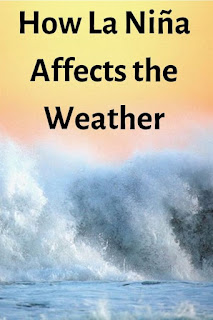Understanding these different weather patterns and looking back, weatherman can forecast possible severe weather, storms and droughts for the next year. This helps farmers and ranchers and everyone else anticipate how the next season might be.
What Causes La Niña
La Niña and El Niño have to do with what is called the El Niño Southern Oscillator Process (ENSO), which is the technical name for phenomena that occurs when the sea surface temperature of the tropical Pacific Ocean differs from normal.
Scientists monitor the tropical Pacific Ocean for temperature variations and extremes and how this interacts with the atmosphere.
When the sea surface temperature of the eastern Pacific Ocean becomes cooler than normal, a La Niña is occurring. If the temperature of the eastern Pacific Ocean becomes warmer than normal, an El Niño is occurring.
The area of the tropical Pacific Ocean where the temperature is monitored is the central and eastern Pacific Ocean off the west coast of South America near Peru west to about the International Date Line along and near the equator.
Scientists can monitor the Pacific Ocean temperatures with a system of buoys and satellites.
The trade winds are an important factor and can cause a La Niña to occur. A change in the trade winds can cool or warm the temperature of the eastern Pacific Ocean depending on the direction and strength of these trade winds.
The trade winds are the normal flow of winds blowing out of the east (from east to west), from western South America out into the Pacific Oceans.
When these easterly trade winds become stronger than normal, they blow the warm ocean waters westward into the central and western Pacific Ocean towards Indonesia.
When this occurs, the colder subsurface water off the west coast of South America is allowed to come up to the surface and this cools the surface water temperature of the eastern Pacific Ocean, usually around Peru and Ecuador.
This is when a La Niña is starting to build, when the easterly trade winds blow the warm Pacific water west, which causes upwelling of the ocean, bringing up cold water from down deep.
The upwelling of deeper cold water cools the surface temperature of the central and eastern Pacific Oceans.
El Niño occurs when these easterly trade winds are weak, change direction or stop blowing all together, causing the Pacific Ocean waters to heat more than normal off the western South America coast, the opposite of La Niña.
What is Normal Weather?
Some scientists think El Niño and La Niña are the only two conditions with nothing in between as normal, with either El Niño or La Niña conditions occurring.
Dr. Kevin Trenberth, a scientist for the National Center of Atmospheric Research (NCAR), believes that La Niña happens 23% of the time, El Niño happens 31% of the time and the rest of the time is the normal pattern. Many times La Niña will follow an El Niño event, but not always.
A La Niña usually happens every 3 to 5 years and varies from 2 to 7 years. La Niña patterns usually last 1 to 3 years with the most noticeable effects occurring from December through March.
How La Niña Affects the Weather
The jet stream is an important factor in worldwide weather conditions and both El Niño and La Niña affect the strength and the position of the jet stream.
Usually, when you are north of the jet stream (in the northern hemisphere), you will be in the stormy weather area, since storms move along the jet stream, the worst of the weather is to the north of the jet stream.
 |
| Differences between El Nino and La Nina / NOAA |
La Niña Weather in the United States
During La Niña years, it is common for the northern United States to be colder and snowier while the southern parts of the US are warmer and drier, causing droughts in both the southeastern and southwestern US.
As we are seeing in the 2010/2011 La Niña, the Pacific Northwest and upper Midwest are much stormier and colder.
La Niña Research
Scientists have become more interested in La Niña since it does affect the weather, just in different ways than El Niño does.
A worldwide program called GLOBE, primarily in schools, allows teachers and students to participate and help scientist gather weather readings which will help them to better understand the global impact La Niña and El Niño have on the planet’s weather.
Here is a chart of El Niño and La Niña years,you can use this and look at your own weather history and see how your weather was during these years [NWS].
Copyright © 2010-2014 Sam Montana
Resources
NOAA Climate Prediction Center



No comments:
Post a Comment